All products featured are independently chosen by us. However, SoundGuys may receive a commission on orders placed through its retail links. See our ethics statement.


Sony WH-1000XM4
August 18, 2020
Original: $349 USD
1.2m (cable)
251g
WH-1000XM4
The Sony WH-1000XM4 builds upon its predecessor, the Sony WH-1000XM3. The WH-1000XM4 continues to give Bose competition and features multipoint connectivity, speak-to-chat functionality, and a host of other advanced software features. This time around, Sony forges ahead of the pack, and with the advent of the Sony WH-1000XM5, you can get the XM4 headphones for a steep discount. Does this set of Sony headphones have the heart to continue fighting against its competition or do others overtake it? We spent two weeks with the Sony WH-1000XM4 active noise canceling (ANC) headphones to find out.
Editor’s note: this review was updated on April 20, 2023 to include the Sennheiser Momentum 4 Wireless in the alternative recommendations.
Just about everyone can find something to love with the Sony WH-1000XM4. I can’t think of anyone who wouldn’t enjoy owning these. If you have the cash to splurge on a top-tier pair of headphones these are a no-brainer. Anyone who wants the best active noise canceling should also check these out. The WH-1000XM3 was already a great pair of active noise canceling (ANC) headphones, and now the WH-1000XM4 is even better. Additionally, commuters and jet-setters will appreciate the battery life, noise canceling, sound quality, and not needing to choose between them.
What’s it like to use the Sony WH-1000XM4?
While the WH-1000XM4 is almost identical in looks to its predecessor, there are some new features tucked away inside. Bluetooth multipoint makes it slightly more convenient in everyday use because you can connect to two devices at once (more on that later). It makes it easy to transition from listening to music while working at your desk to watching a YouTube video on your phone, and back again, all without opening your Bluetooth settings. Caveat alert: if you’re going to use multipoint, both connected devices need to use the AAC Bluetooth codec.
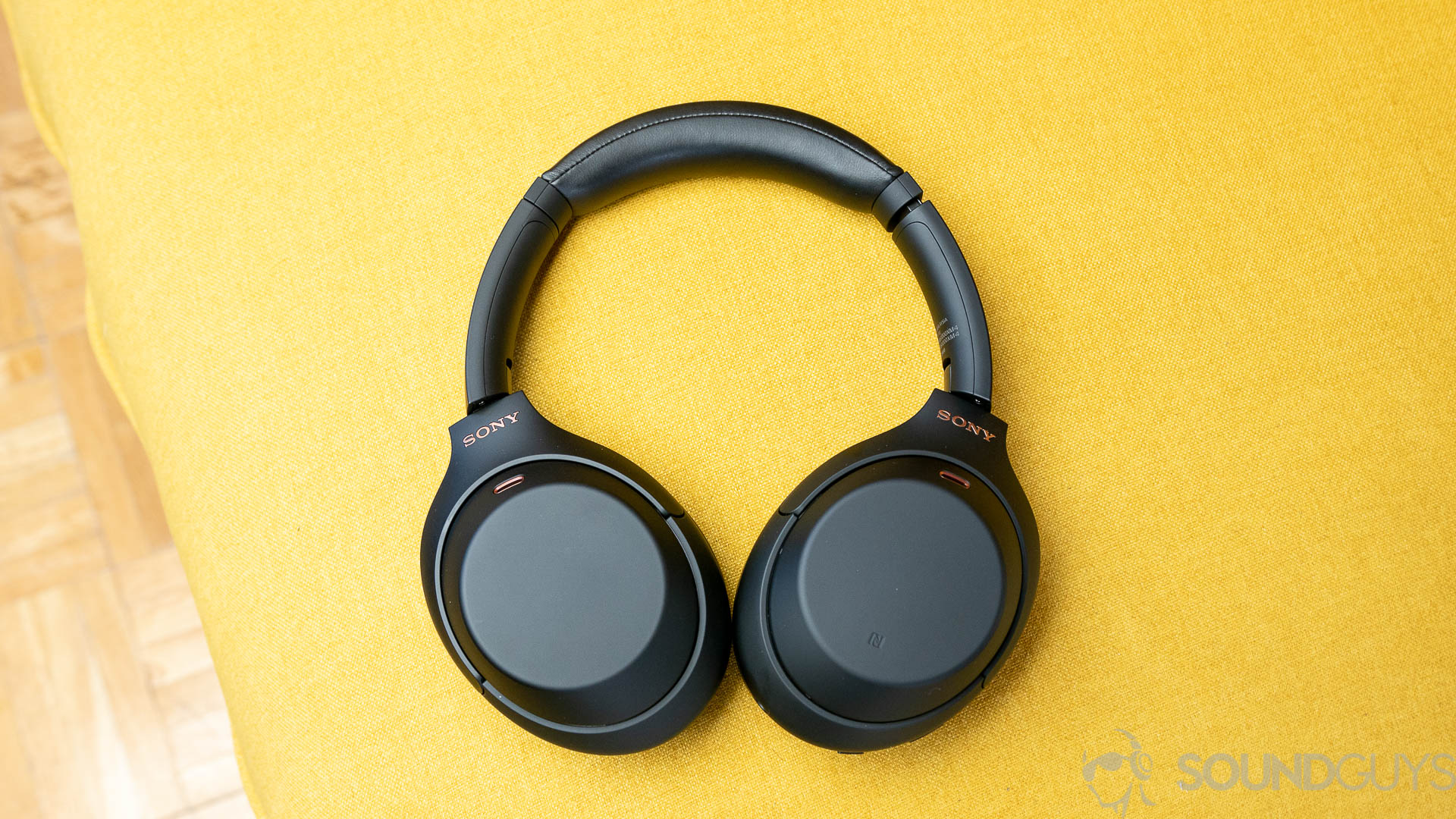
Aside from the ability to stay connected to two devices at once, there’s also a few new features you can only access if you download the Sony Headphones Connect app, such as the speak to chat functionality. When turned on this will pause your music whenever the headphones detect that you’re speaking. While it definitely works, the feature treads a fine line between useful and annoying, especially considering how sensitive the detection is.
For example, while listening to a podcast, the WH-1000XM4 pauses the media when I chuckle at a joke. You’re never really aware of how many weird sounds you make until you’re wearing a pair of headphones that pause your music each and every time you make one. It could be useful to some people, but many will probably just turn it off.
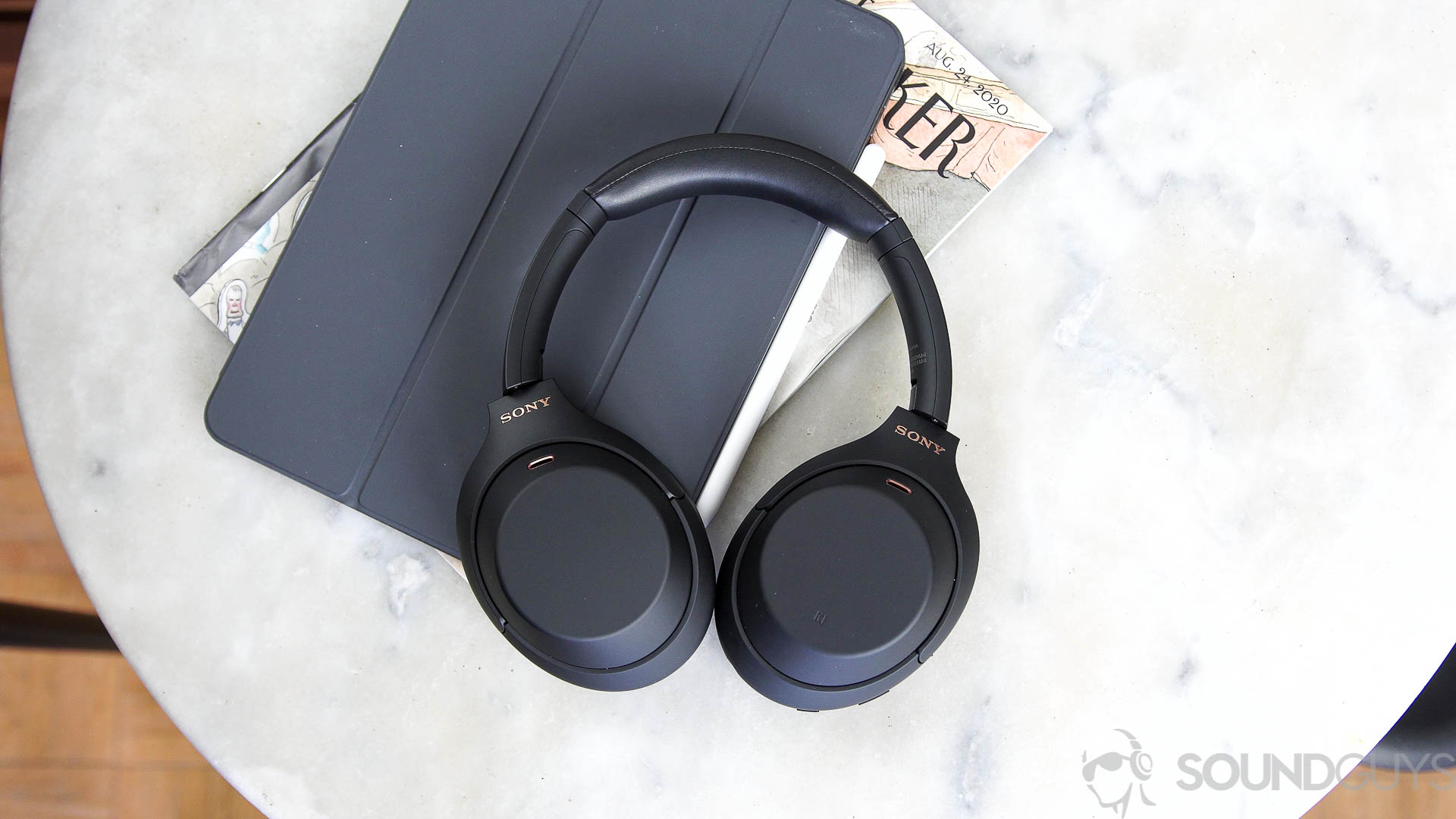
Along the same lines is the auto-pause feature, which stops playback when you remove the headphones. On the inside of the left ear cup is a small sensor that detects when you’re wearing the headphones or not, and pauses music when you take the headphones off. Is it a must-have feature? Absolutely not, but it’s the kind of subtle touch that you’d expect from a $350 USD pair of headphones and Sony nails it here.
The ear cups are also slightly thicker than the previous pair, which results in better isolation even when noise canceling is turned off. On the other hand, the headband itself is thinner with a little less padding, and I feel it. While the padding is definitely comfortable, there was an ever-present pressure at the crown of my head that only became more pronounced with longer listening sessions.
How do you control music on the Sony WH-1000XM4?
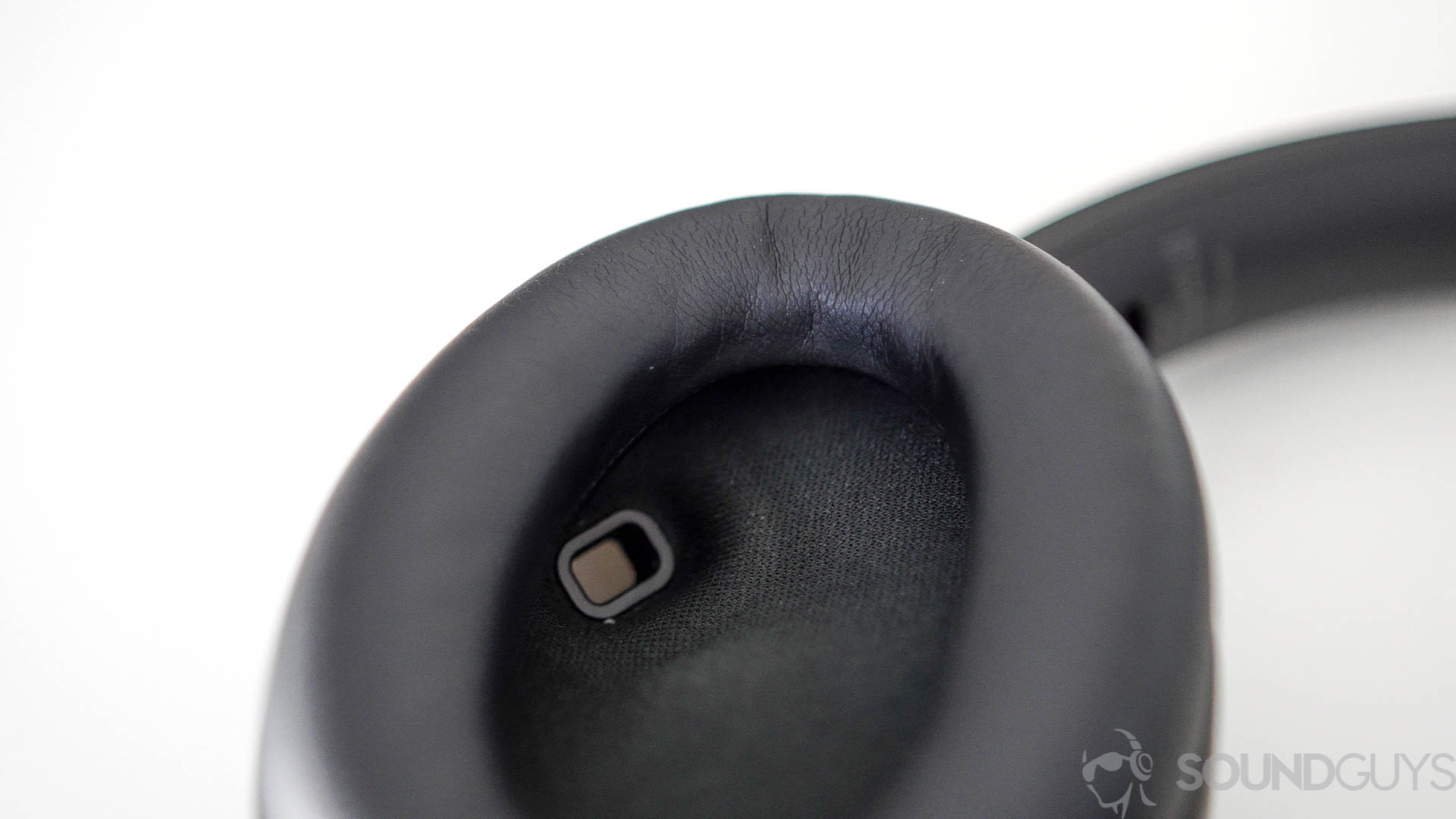
The WH-1000XM4 controls haven’t changed much from the previous version. Both ear cups are still touch sensitive, and you control playback with a series of taps and swipes. Unfortunately, the double-tap to pause function only actually works some of the time. Swiping to control volume and skip between songs works seamlessly, but for some reason, the headphones struggle to register taps. Sometimes it’s easier and quicker to simply take off the headphones and let music auto-pause.
Cupping your hand over the left ear cup activates ambient mode, which is one of my favorite features. It dramatically lowers the music and uses the microphones built into the headphones to play what’s going on around you. Not a huge deal for anyone still spending most of their time at home, but useful if you need to quickly catch an announcement from the pilot or train conductor while commuting.
Should you get the Sony Headphones Connect app?
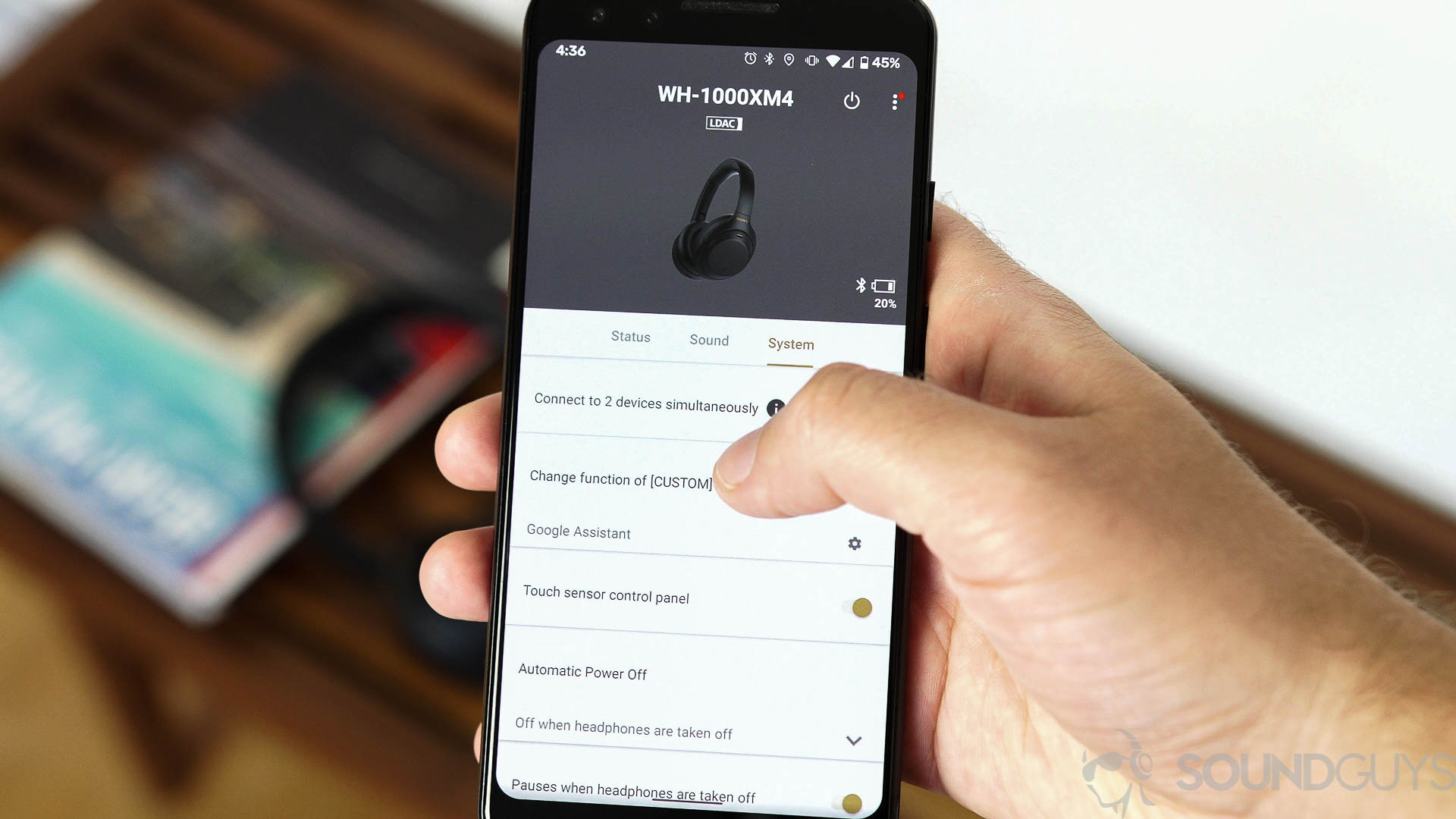
To get the most out of the WH-1000XM4 headphones, you will have to download the accompanying Sony Headphones Connect app that I mentioned earlier. While you’re able to rip the headphones out of the box and use them as is, you won’t be able to customize anything about them or use some of the cooler new features unless you use the app. For example, the second button on the headphones can be customized to either activate the assistant on your phone or toggle noise canceling.
Unfortunately, you can’t have both—and downloading the app is the only way to choose whichever one you want. These are compatible with both the Google Assistant and Amazon Alexa so whichever one you prefer you can use them seamlessly. Sony headphones can no longer support Google Assistant on iOS, though.
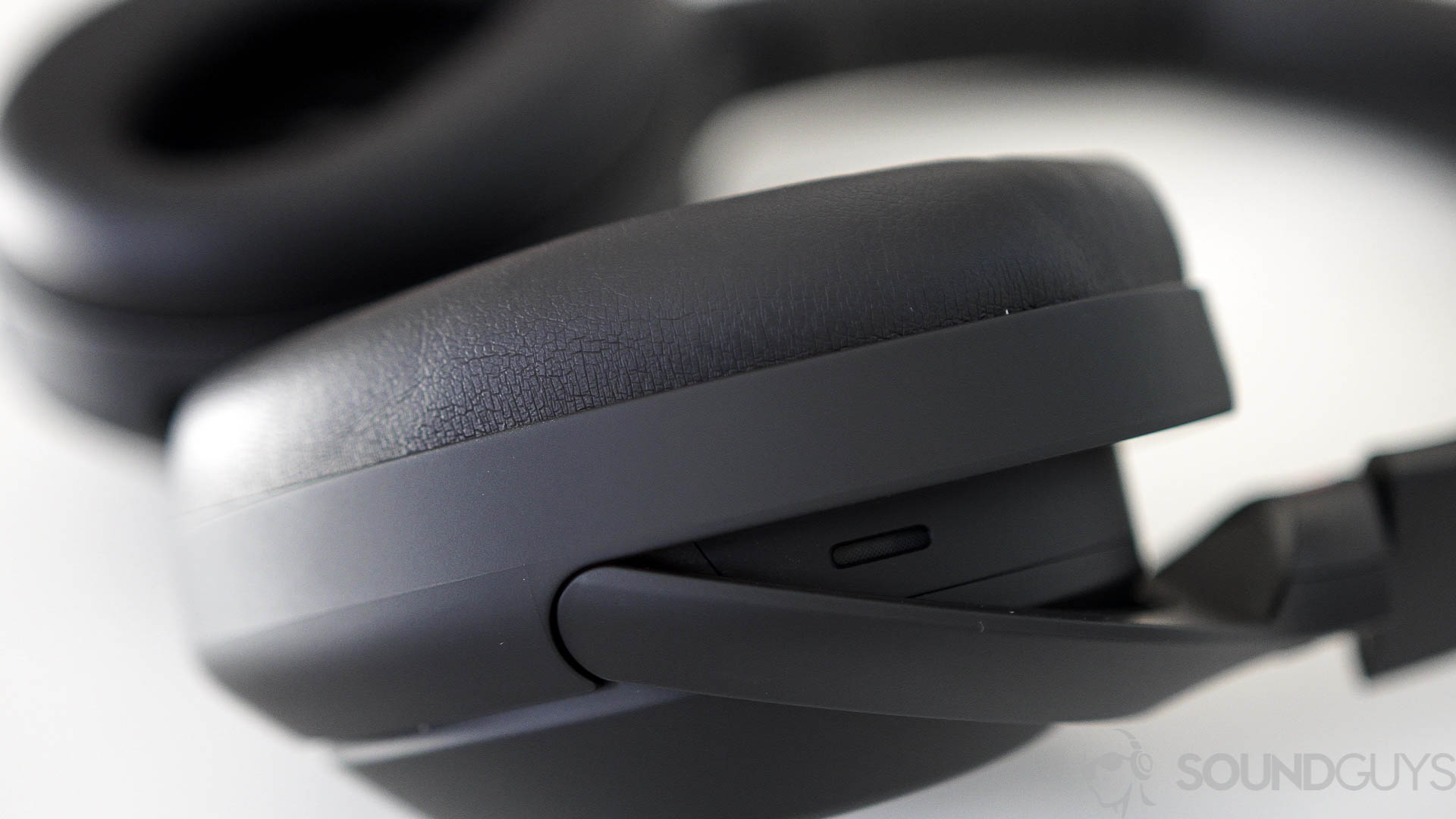
There are two other features unique to the app: noise canceling optimization and 360-degree sound. While the noise canceling is already excellent out of the box you can optimize it for whatever situation or level of air pressure you’re currently in via the app. You can also adjust the mix of ambient sound that’s fed through the headphones to your ear, so you can hear what’s going on around you. Of course, you can always cup your hand over the right earcup to allow a full passthrough so you can order a cardboard-tasting lunch from the friendly flight staff in economy class.
In the app, there’s also a way to EQ the WH-1000XM4 to sound how you want it to. This isn’t exactly a new feature, but downloading the app is the only way to access it. Bluetooth multipoint gets activated by using the app as well. For that feature alone it’s worth downloading.
A slightly cooler feature that’s only available via the app, is access to Sony’s 360 Reality Audio. This is a new way of mastering music Sony has really been pushing and admittedly: it’s pretty awesome. It is really just Sony’s version of object-based surround sound in its headsets, and it can breathe new life into old favorites.
You can only stream it on high-quality music services like Deezer, Amazon Music HD, or Tidal—if you’re already a subscriber, these are just that much more attractive, but if you’re on Spotify you’ll be missing out.
What Bluetooth codecs does the Sony WH-1000XM4 support?
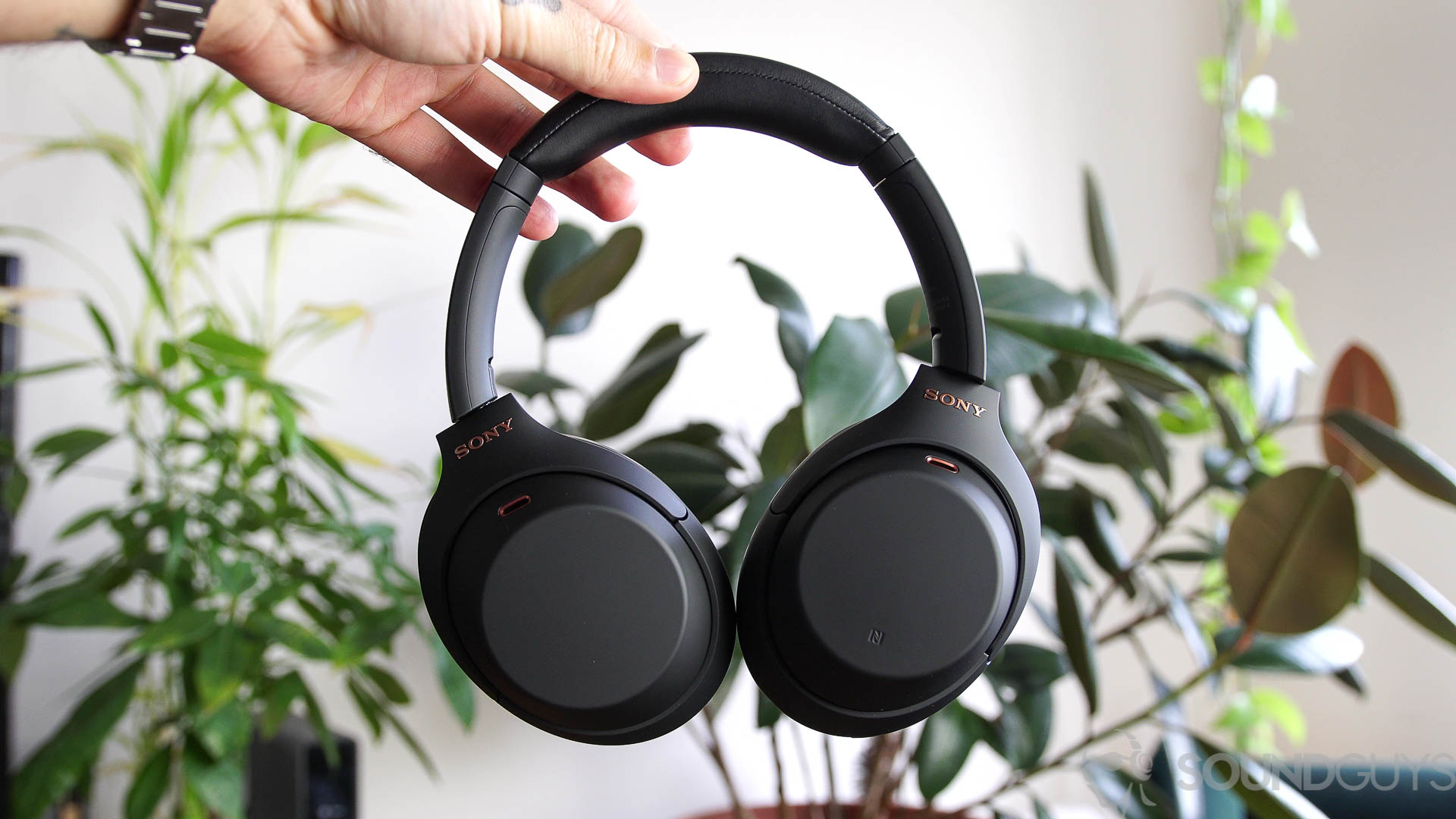
The Sony WH-1000XM4 uses Bluetooth 5.0, has Bluetooth multipoint, and supports SBC, AAC, and Sony’s own LDAC, which has the highest streaming quality possible if you’re willing to deal with a somewhat less-stable connection. If you’re using something that isn’t compatible with any of these codecs then it will default down to SBC, which is the most basic codec shared by all Bluetooth audio devices. Devices that don’t have Bluetooth at all can always connect via the included 3.5mm audio cable too.
However, the multipoint capability is only available if you’re using AAC, and not LDAC or SBC. Depending on what you’re looking to do it might be worth it, but it’s not for me, as I spend most of my time using at least two devices.
The headphones can be customized to either activate the assistant on your phone or toggle noise canceling on/off, but not both.
I live in a fairly average-sized two-bedroom apartment and haven’t had any issues with range. While the Sony WH-1000XM4 is connected to my laptop, I can walk around my entire apartment with no skips. The same holds true with my Pixel 3 smartphone which remains connected regardless of which pocket the phone is in.
Pairing to the Sony WH-1000XM4 is as simple as tapping your phone to the back of the NFC logo on the left earcup and following the prompt that appears on your smartphone. If your smartphone doesn’t have NFC, you’ll need to pair the old-fashioned way by going into Bluetooth settings.
To pair the headset the first time:
- Power on the headphones by holding down the power button.
- If you’re doing this for the first time, the headphones will automatically enter pairing mode.
- Next, you have to navigate to the Bluetooth settings on your device. Search for WH-1000XM4 in the list.
- Tap them to connect.
To pair a second device, it’s a similar process—except the headphones won’t automatically enter pairing mode when you turn them on since they’re already paired to another device.
To pair to a second device:
- Power off your headphones.
- Just like before, hold down the power button to power on the headphones, but this time don’t let you go until you hear the pairing chime (or you see the small LED light start rapidly flashing blue.)
- Navigate to Bluetooth settings on your second device.
- Click on the WH-1000XM4 to connect.
If this method doesn’t go smoothly, you can also enable pairing a second device in the Sony Headphones Connect app and add your second device through the app. Ensure the Status tab shows both devices you want to be connected to.
How is the battery on the Sony WH-1000XM4?
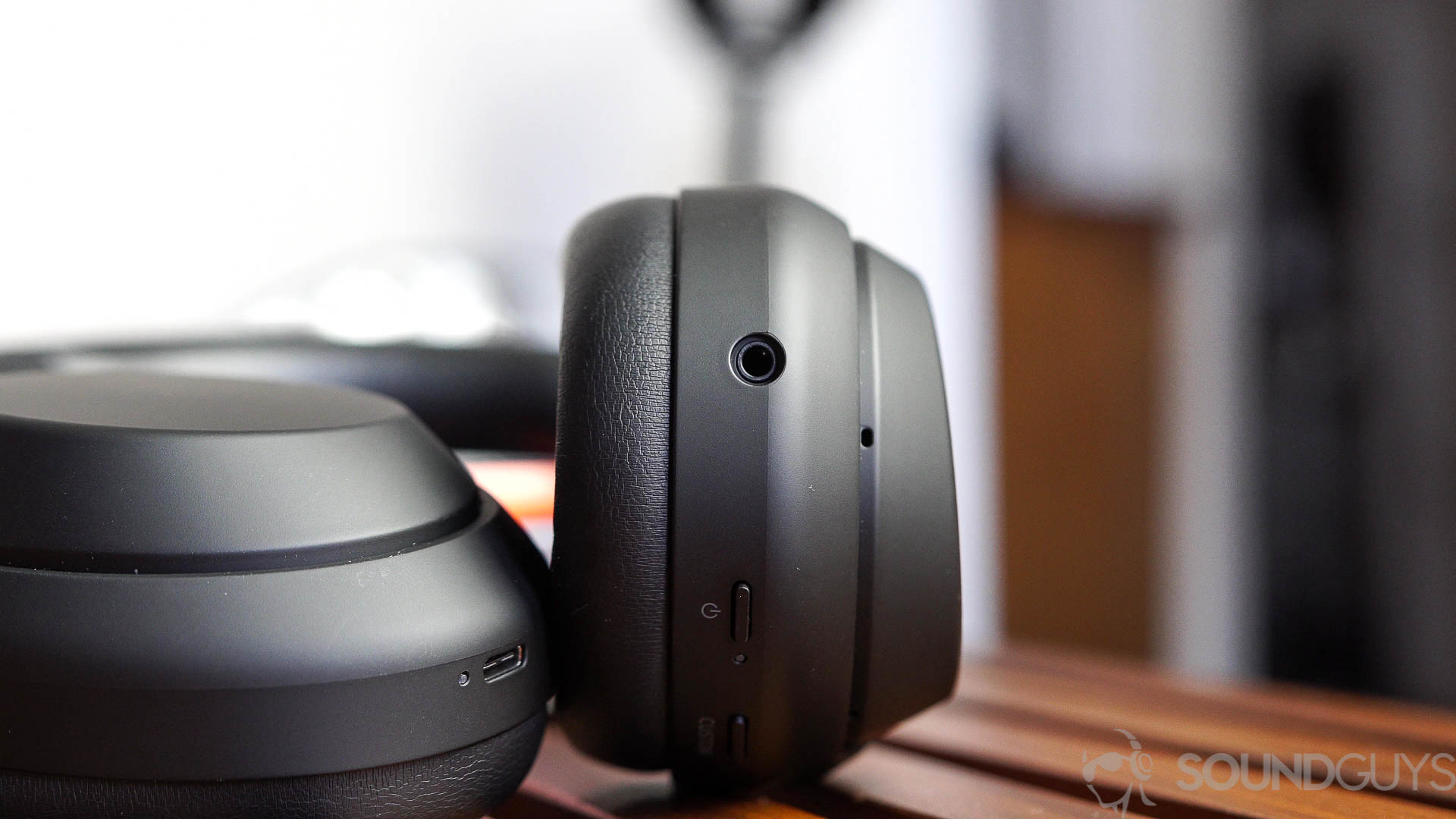
When it comes to battery life, Sony claims these will get you about 30 hours of constant playback which is the same as the previous WH-1000XM3. In our testing, we turn the headset’s ANC on in Bluetooth and play music with a peak output of 75dB(SPL). Under these conditions, the WH-1000XM4 lasted exactly 19 hours, 59 minutes (sorry Sony, we test down to the minute).
This is obviously still great and more than good enough for most people, but I find it odd this doesn’t last as long as its predecessor, which clocks in at about 24 hours. It’s entirely possible that as the unit we tested is a pre-production unit, there are some software gremlins yet to be solved, so we’ll re-test and update this review once the production unit comes in.
When you place your hand over the left ear cup, ambient mode immediately activates.
The Sony WH-1000XM4 charges via USB-C, and the quick charge feature will get you 5 hours of playtime after only 10 minutes of charging, which is fantastic if you’re already late to catch the bus or train.
How well does the Sony WH-1000XM4 cancel noise?
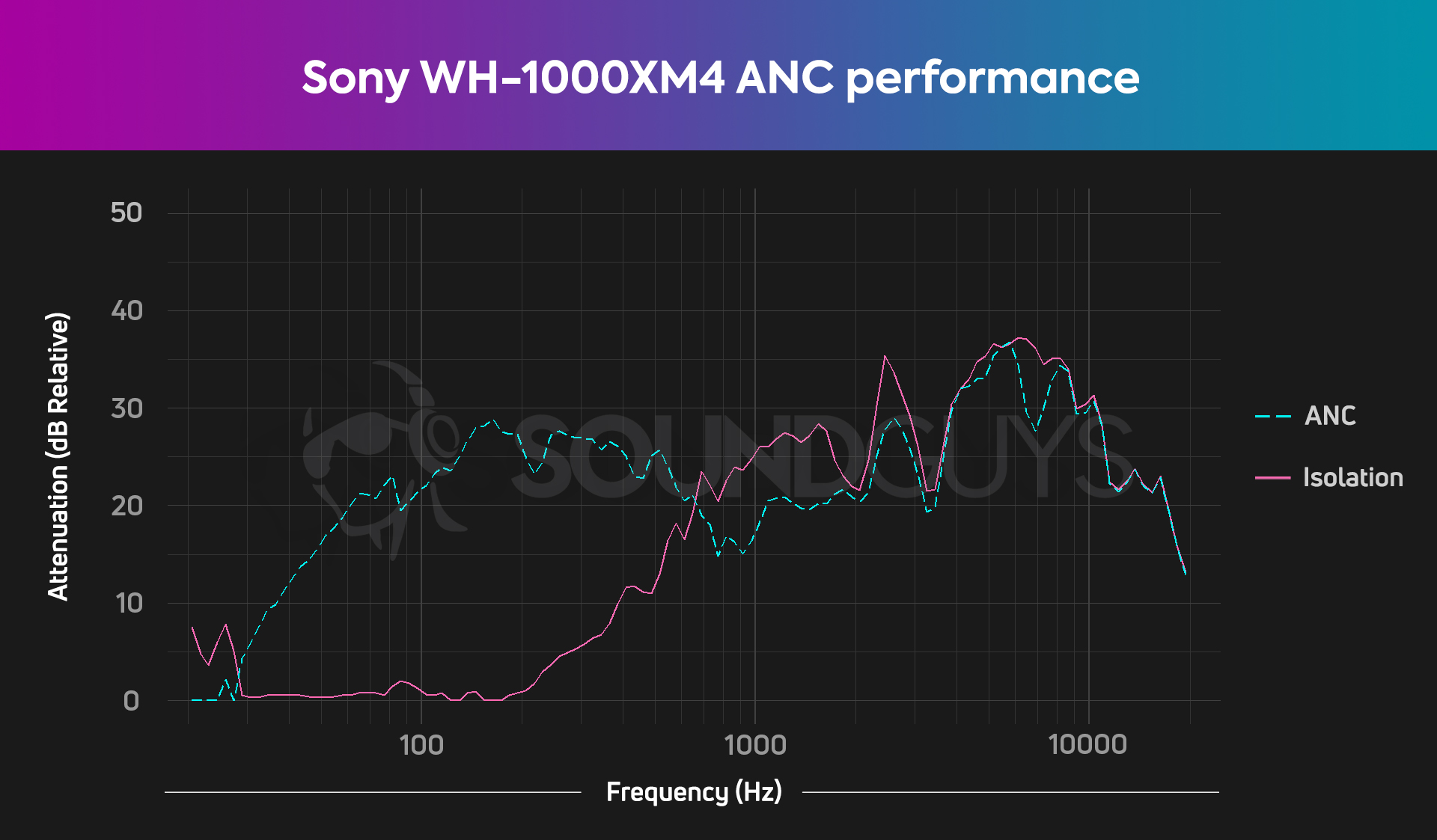
If you were hoping for an improvement in noise canceling with the WH-1000XM4, these are going to make you very happy. Somehow, the team at Sony made the ANC even better than before.
Plots like the one above give a rough idea of how much noise is cancelled across the audible spectrum of 20Hz-20kHZ (the limits of human hearing). Taller peaks in the chart above correspond to more noise being removed. The WH-1000XM3 isn’t a slouch where ANC is concerned, but the Sony WH-1000XM4 is better in its ability to attenuate lower-frequency sounds like the low hum of an air conditioner, or the constant rumble of a jet engine than most other headsets.
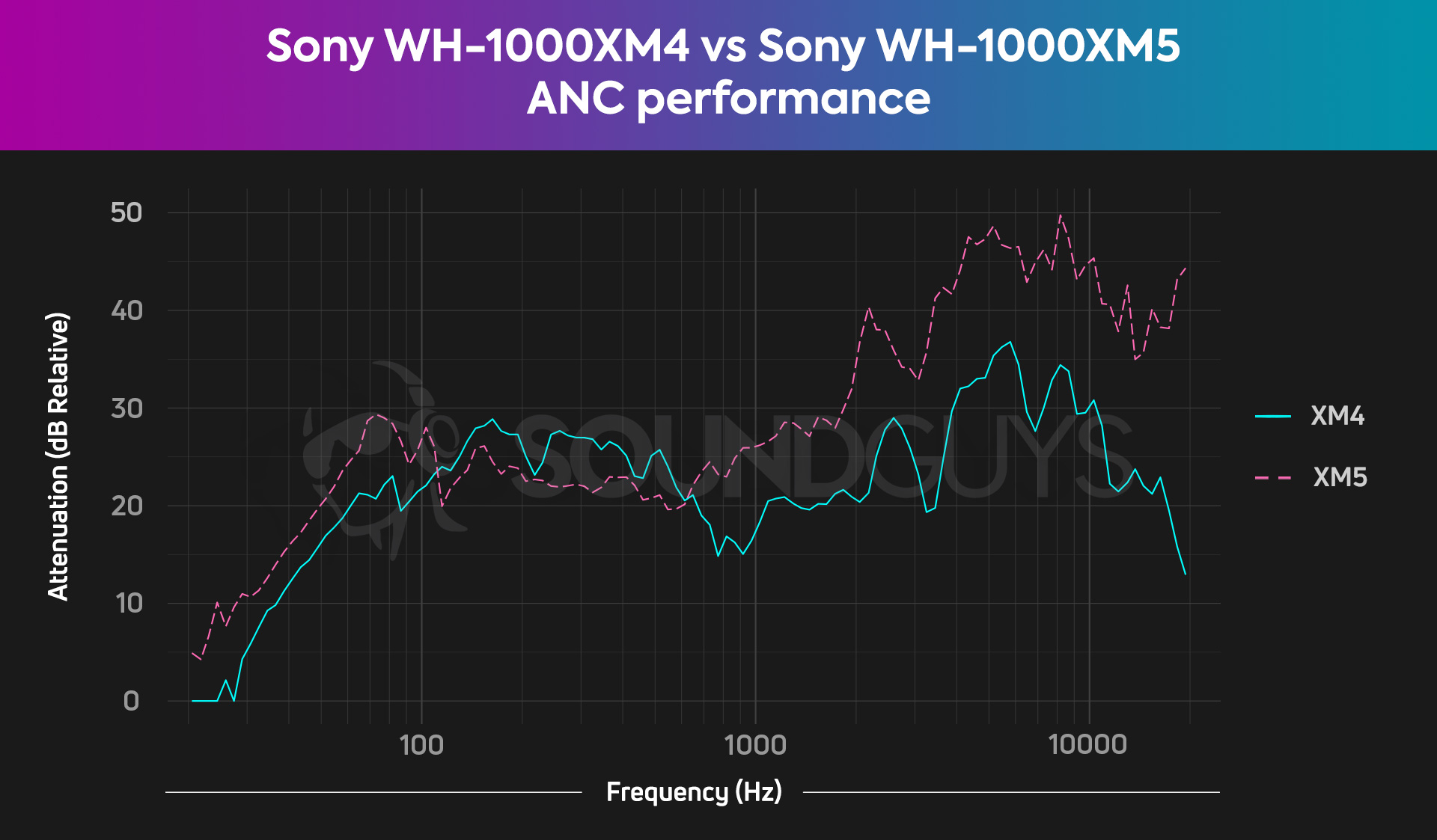
Yes, the Sony WH-1000XM5 has better active noise canceling than the WH-1000XM4, and out of all flagship headphones, only the AirPods Max unquestionably outdoes the WH-1000XM5. Super-low sounds below 100Hz are blocked out more through the WH-1000XM5, as are midrange and high-pitched frequencies. Sony’s XM5 headphones do way more to block out unpredictable sounds like a mechanical keyboard or slamming cabinets than the XM4 headphones. That said, the WH-1000XM4 has a minor leg up on the newer XM5 when it comes to 120-600Hz frequencies, and renders them 1-5dB quieter than the XM5.
You can read all about how these two headsets compare in our Sony WH-1000XM5 vs Sony WH-1000XM4 article.
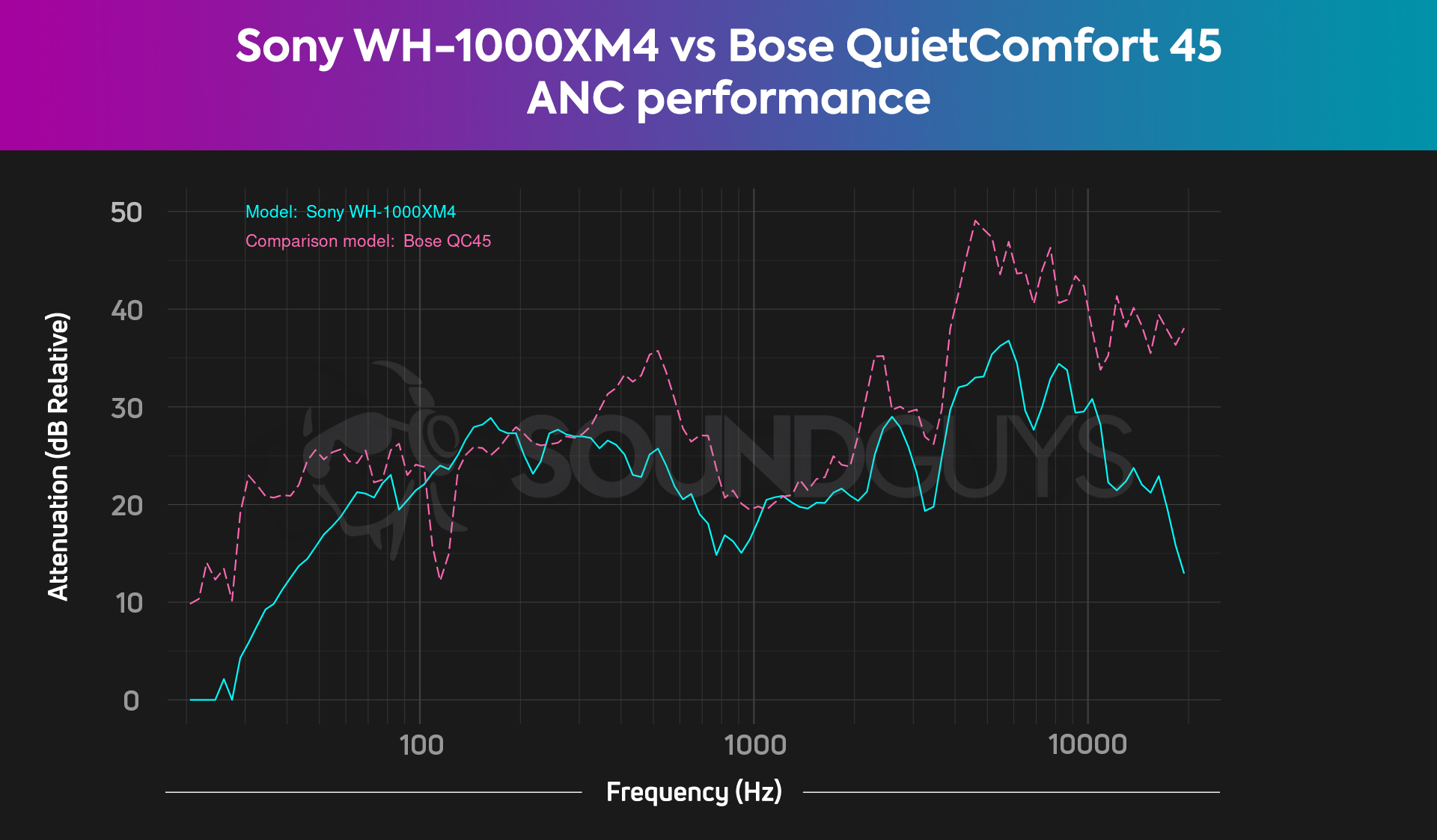
When comparing the Sony XM4 headphones to the Bose QC 45 headphones, it’s clear that Bose generally has better ANC, save for an odd dip around 100Hz. If, however, you can get a good fit with the QC 45 around your ears, you’ll enjoy current-generation ANC performance that outdoes yesteryear’s flagships. One caveat of the Bose QC 45 is that you can’t turn ANC completely off without immediately enabling transparency audio. This means you’re unable to use the QC 45 as a non-ANC headset, unless you want to hear what’s going on around you.
You can read all about how these two headsets compare in our Bose QuietComfort 45 vs Sony WH-1000XM4 article.
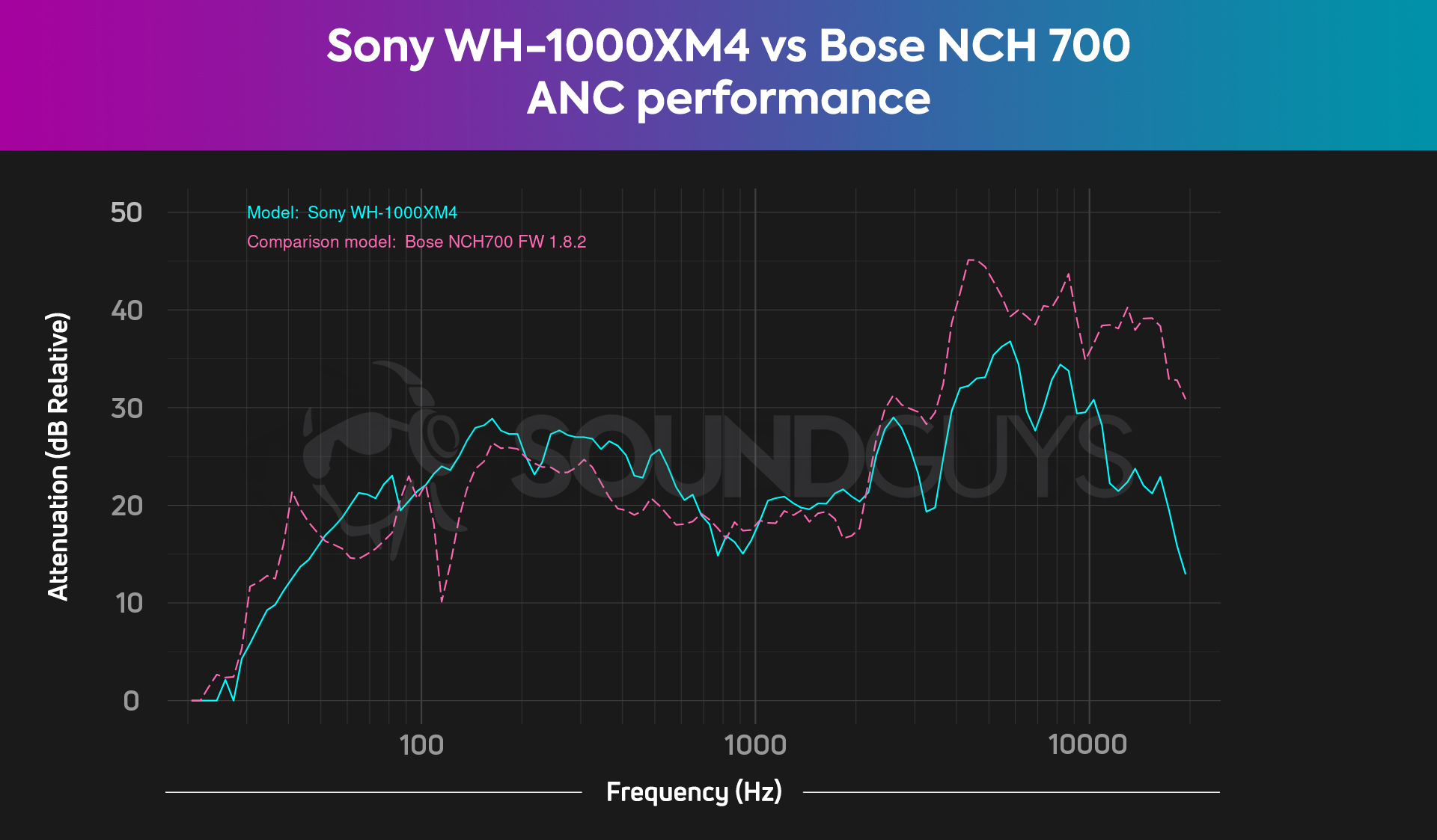
Not necessarily, the Bose Noise Canceling Headphones 700 (NCH 700) has slightly worse attenuation until the 2kHz mark where you can hear the benefits of Bose’s stiffer, denser ear pad material. From 20-2kHz, the Sony WH-1000XM4 does a bit more to cancel out noise than the NCH 700, but this is dependent on your ability to get a proper fit.
You can read all about how these two headsets compare in our Bose Noise Canceling Headphones 700 vs Sony WH-1000XM4 article.
How does the Sony WH-1000XM4 sound?
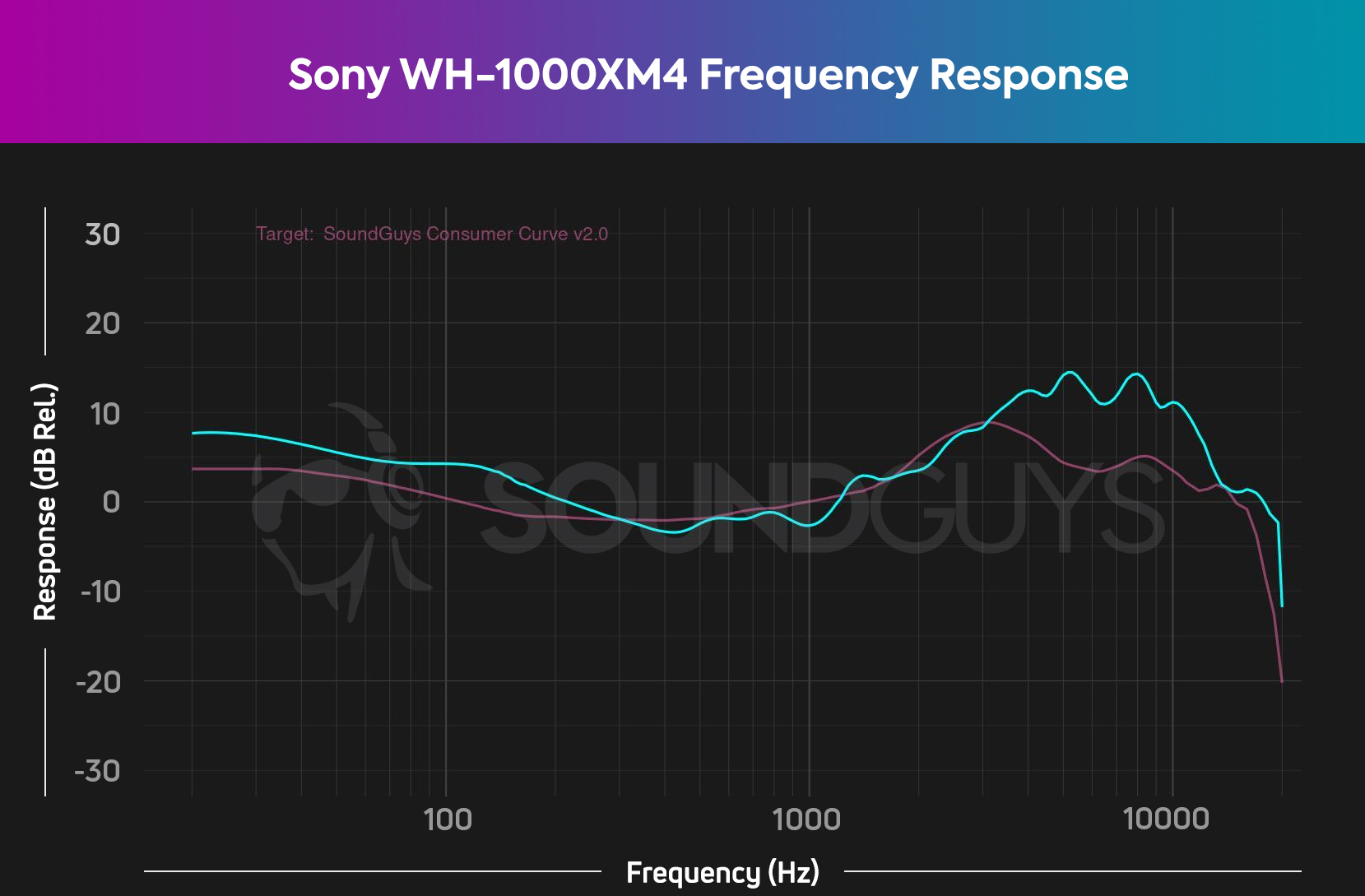
Sound quality for the Sony WH-1000XM4 is one of those subtle things Sony also improved over the last model. That’s not to say that the XM3 sounds bad—it sounds great—but the older model definitely has more of a consumer-friendly bump in the low end.
The more neutral-leaning frequency response in the lows translates to a sound that doesn’t get a huge bass boost as you’ll find on some other headphones. While it isn’t for everyone, most people won’t have a problem here. If you do want more low-end emphasis, you can always just change the EQ preset in the app.
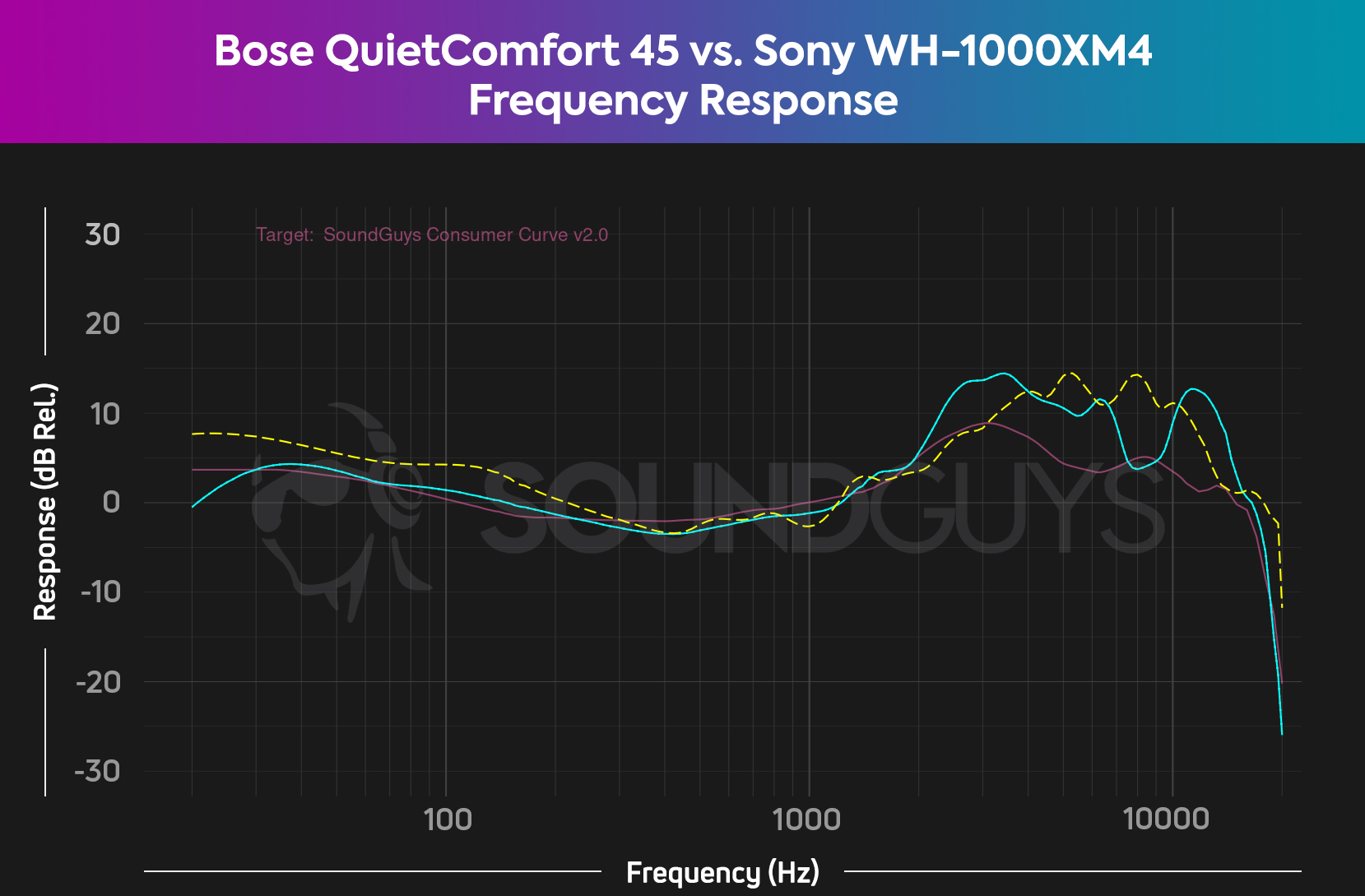
The Bose QuietComfort 45 doesn’t sound quite as good as the WH-1000XM4 right out of the box. The QC 45 is also more expensive and has fewer codecs too. If you’re a bass lover, stick with the WH-1000XM4. However, not everyone likes that kind of sound—especially podcast junkies and classical music enthusiasts. Bose’s headphones are slick and offer a lot of good features—but if you want higher-bitrate codecs, Bose ain’t it.
Lows, mids, and highs
As is, the bass is perfect for subtle performances like Bach’s Violin Partita No. 2 in D Minor by Hilary Hahn, where the low notes hit at just the right volume. The rumbles at the beginning of Pixel Empire by Madeon also sound great, and you can hear the variations in the rumbles throughout the intro. That same attention to detail carries over to the mids.
The lyrics in Constellations by Darwin Deez are clearly audible throughout the entire song regardless of what’s going on. Cymbals, shakers, and claps throughout the song also benefit from the slight increase in volume. In short, these sound great.
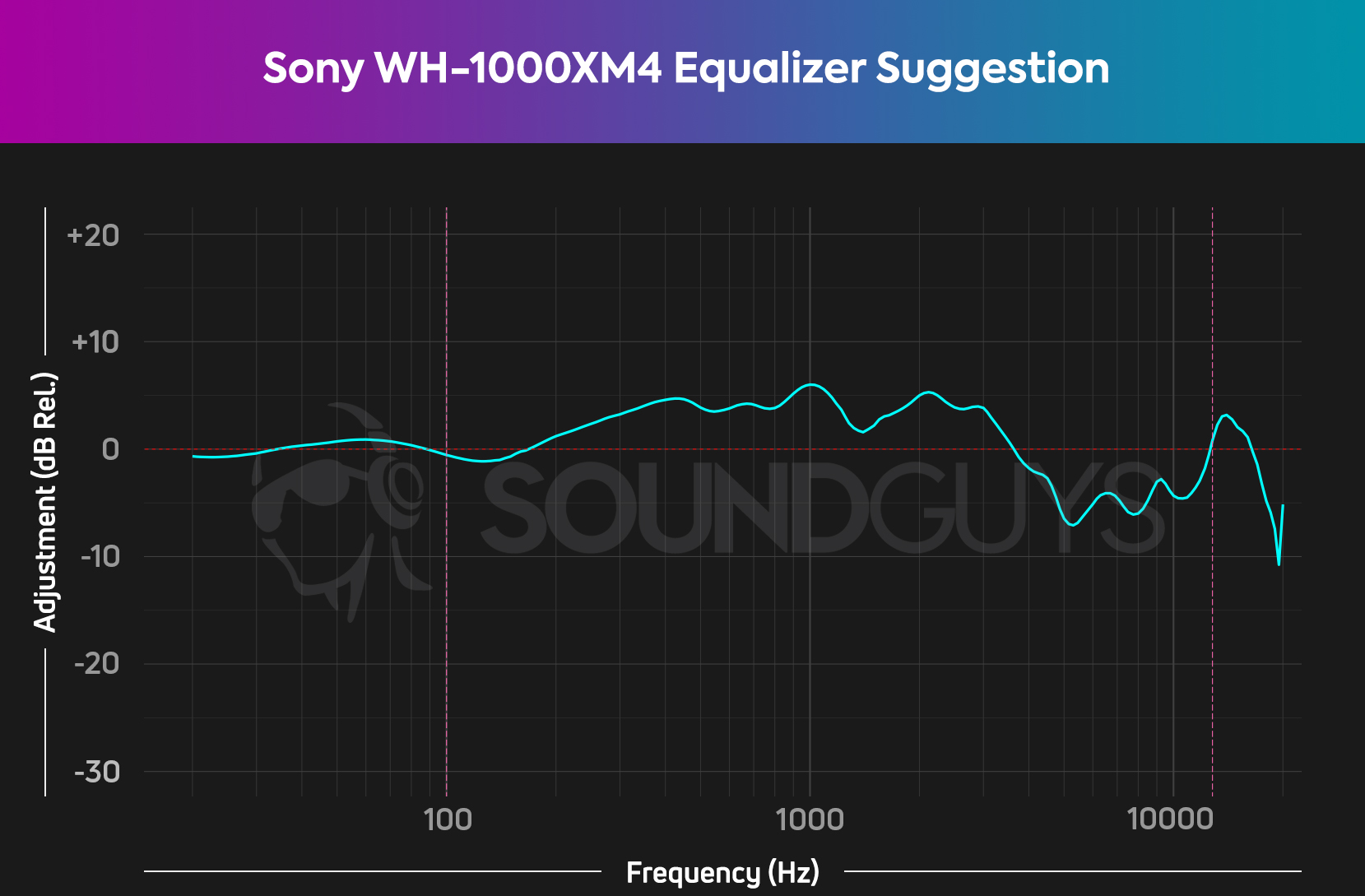
If you want to make these headphones sound better than they already do, you can either use the equalizer in the Sony Headphones Connect app, or you can use a PC-based solution like Equalizer APO, Roon, or Voicemeeter. Follow the below chart as a loose guide for your adjustments to get the sound to better fit our house curve. From there, boost and cut targeted bands as you wish to get the desired result.
We should mention that you should avoid getting too crazy with equalizers in general, as there is a point of diminishing returns. You may also not be able to get the granularity you’d need for an adjustment like this in apps with limited bands. Just take it slow and use a light hand, you’ll be fine.
How is the microphone quality on the Sony WH-1000XM4?
The microphone on the Sony WH-1000XM3 is good, and it isn’t much different here. There is a slight drop-off in low frequencies, which isn’t unusual for Bluetooth headphones, but it’s more pronounced than on the previous version. It should still be good enough to get you through your phone calls and Zoom meetings.
Sony WH-1000XM4 mic demo (Ideal):
Sony WH-1000XM4 mic demo (Office):
Sony WH-1000XM4 mic demo (Wind):
How does the microphone sound to you?
As of March 24, 2021, 4,286 readers rated the above mic sample as somewhere between “okay” and “good.” This is a pretty typical result for wireless headset microphones, and at the upper end of what you should expect to get out of any products of this type.
Should you get the Sony WH-1000XM4?
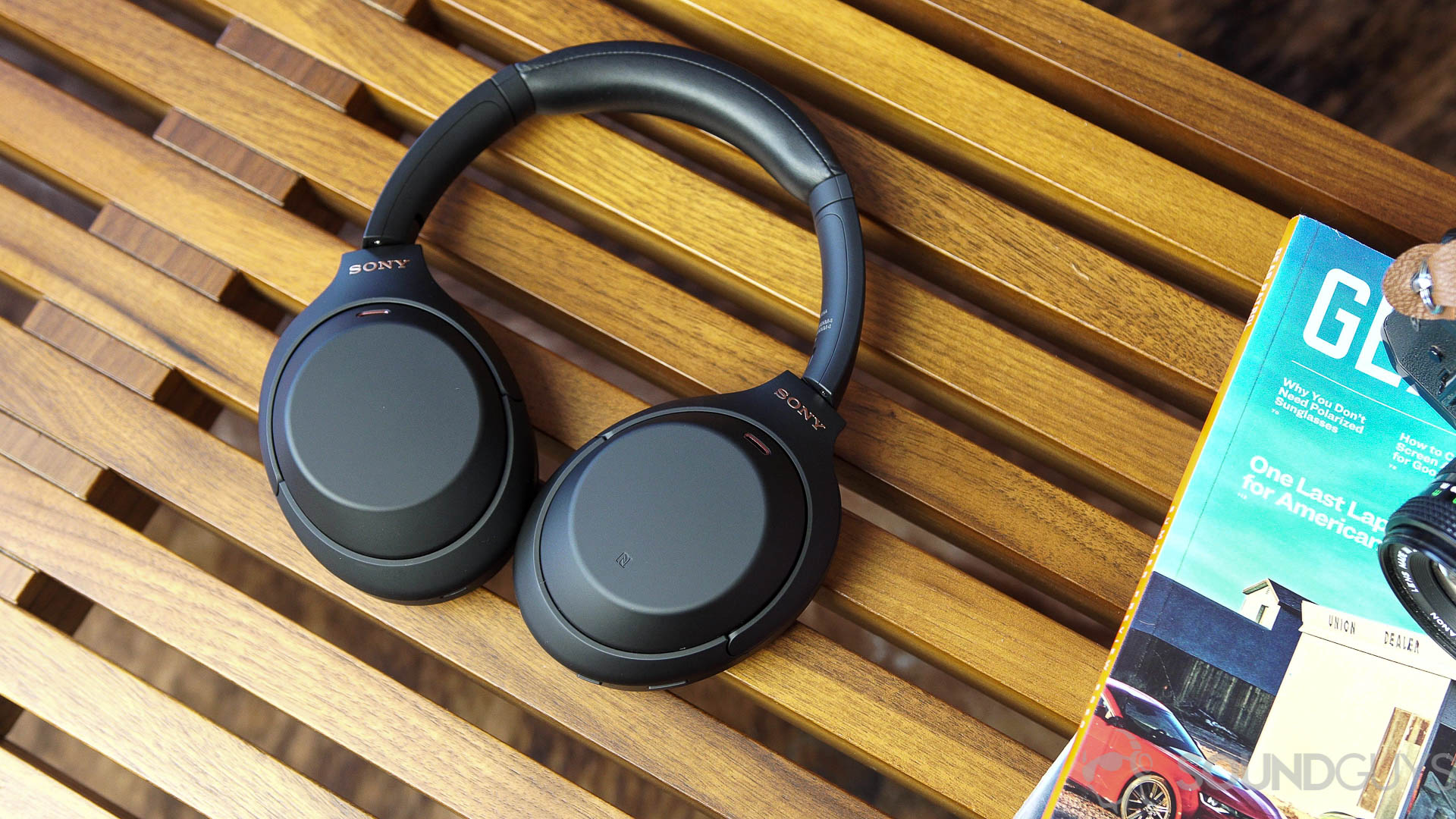
If you’re in the market for the best pair of Bluetooth headphones you can get, then yes, the Sony WH-1000XM4 should be on your shortlist. As of March 14, 2022, you can purchase the Sony WH-1000XM4 for as low as $269 USD if you get a refurbished model, making it a bargain buy. The previous WH-1000XM3 is still one of our most recommended headphones, and Sony made it even better. Bluetooth multipoint makes it way more convenient, and subtle improvements to the noise canceling and sound quality make this a compelling buy.
If you have the Sony WH-1000XM3 already, there really isn’t a huge need to upgrade unless you absolutely need multipoint connectivity. However, if you’re looking to invest in your first big pair of noise canceling headphones, almost everyone will love these.


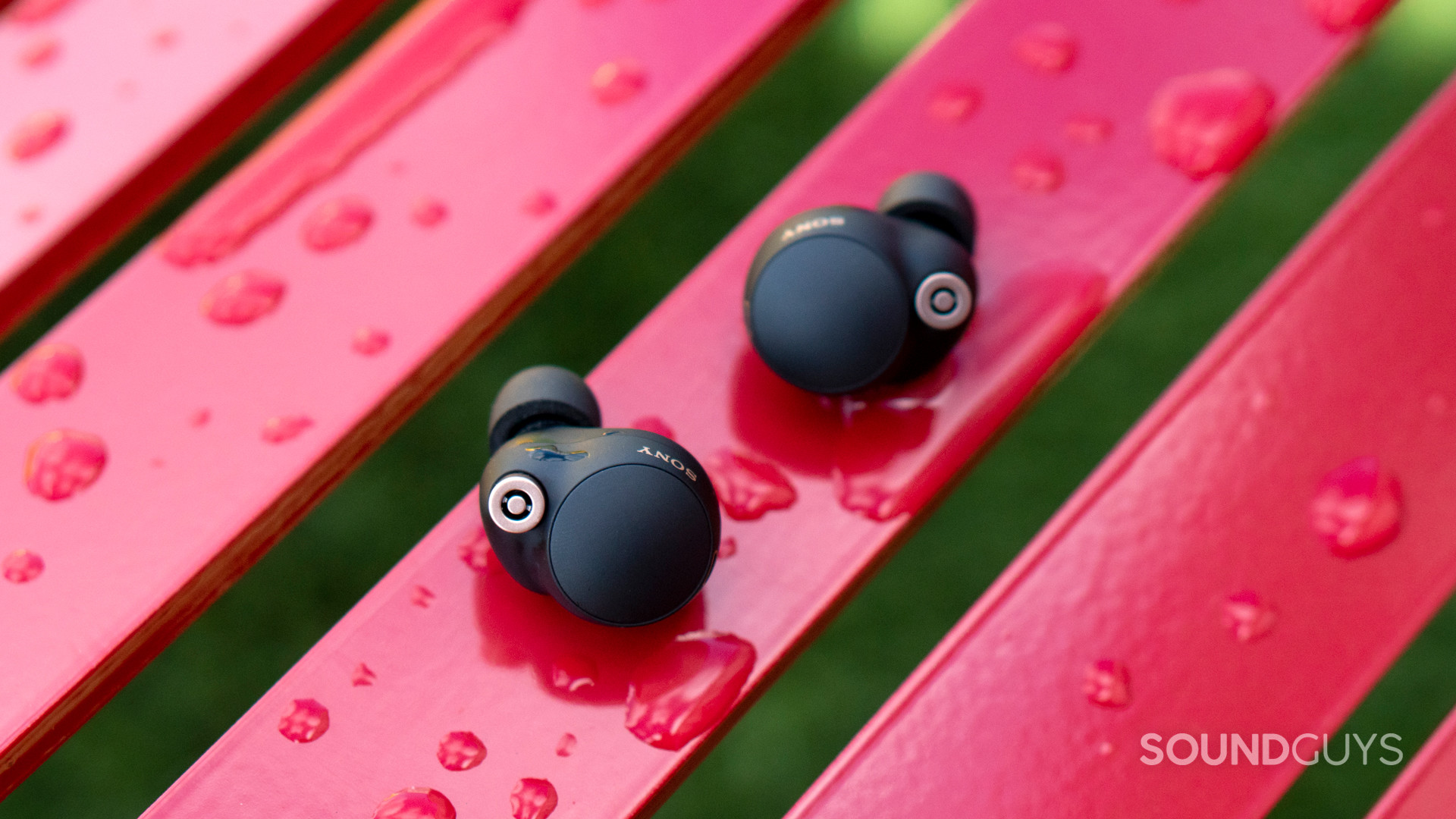
The Sony WF-1000XM4 is a highly compact pair of earbuds from Sony, and just so happens to be its flagship set. With best-in-class ANC, the WF-1000XM4 outperforms almost all other earbuds, with just the Bose QC Earbuds and Sennheiser MOMENTUM True Wireless 3 giving it stiff competition.
If you think the Sony WF-1000XM4 has worse ANC than the WH-1000XM4 just because it’s smaller, think again. The WF-1000XM4 earbuds have stellar passive isolation that takes care of most frequencies above 1kHz. How is this possible? Well, the WF-1000XM4 includes memory foam ear tips that mold to your ear and maximize passive isolation performance. Also, it’s safe to say that Sony’s ANC tech really just is leagues above the rest, even Sony’s own older headset models. (Click the charts to expand.)
Sound quality is rather different between the WF-1000XM4 earbuds and larger WH-1000XM4 headphones. You can see in our chart above that the earbuds under-emphasize treble while the headphones over-emphasize it. Either way, you’ll want to equalize your headset to get a more pleasing sound that works well across music genres.
If space is any kind of real concern, the WF-1000XM4 is a more appropriate choice over the relatively large WH-1000XM4. Noise canceling is very good with either headset and you’ll experience slightly better upper-bass and midrange attenuation with the Sony WH-1000XM4 than you will with the WF-1000XM4. But, Sony’s earbuds do more to block out incidental sounds like nearby laughter or the clang of dishes. We still love the Sony WH-1000XM4, though, because these headphones feature great software features, a supremely comfortable design, and a great microphone system that slightly edges out the WF-1000XM4 in sub-optimal conditions. You can hear the earbuds’ mic performance below.
Sony WF-1000XM4 microphone demo (Ideal):
Sony WF-1000XM4 microphone demo (Office):
Sony WF-1000XM4 microphone demo (Wind):
How does the microphone sound to you?


What about the Apple AirPods Max?
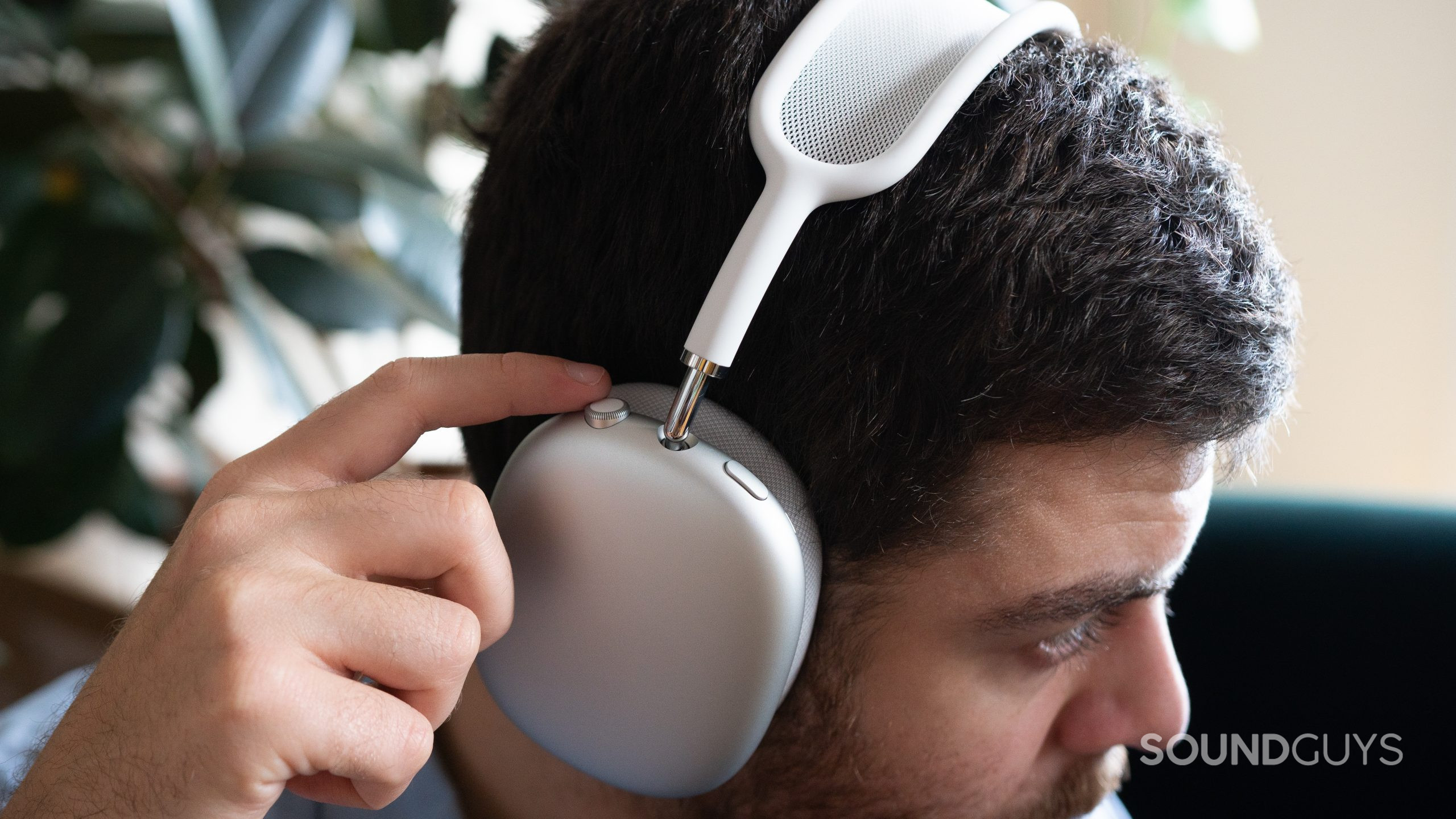
Apple’s AirPods Max is the first pair of headphones from the company. They promise about 20 hours of constant playback with noise canceling turned on, the same H1 chip that you’ll find in the AirPods Pro (1st generation), and a transparency mode as well. Unlike the WH-1000XM4, our favorite AirPods Max alternative, the AirPods Max doesn’t have touch-sensitive controls. Instead, all of the controls are in the digital crown at the top of the ear cup.
Unfortunately, the AirPods Max runs you about $549 USD which is far from cheap. However, while the Sony WH-1000XM4 is much more affordable than Apple’s latest headphones, the AirPods Max does offer better ANC performance. The difference is noticeable, but both headsets do an exceptional job here—and if you were to ask us the increase in price isn’t worth the performance difference for most people, even if it is very good.


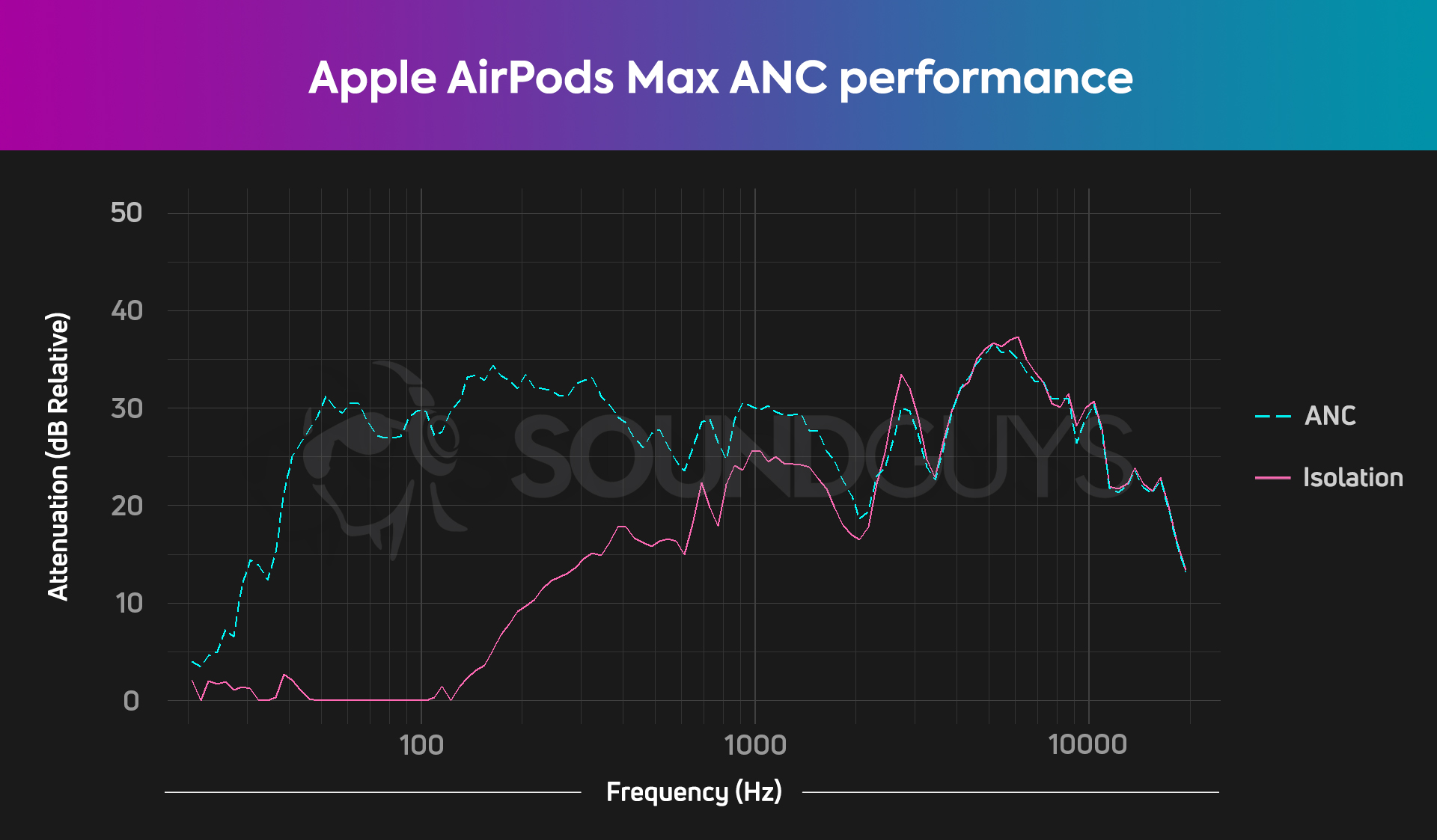
The Apple AirPods Max has the best active noise canceling around, beating out the Sony WH-1000XM4 by 0.5 according to our objective testing. You’ll notice that the AirPods Max renders sub-bass sounds much quieter than the Sony WH-1000XM4, but the WH-1000XM4 is still excellent. If you want the absolute best in ANC, and you have an iPhone, then you can’t beat the AirPods Max.
What should you get instead of the Sony WH-1000XM4?
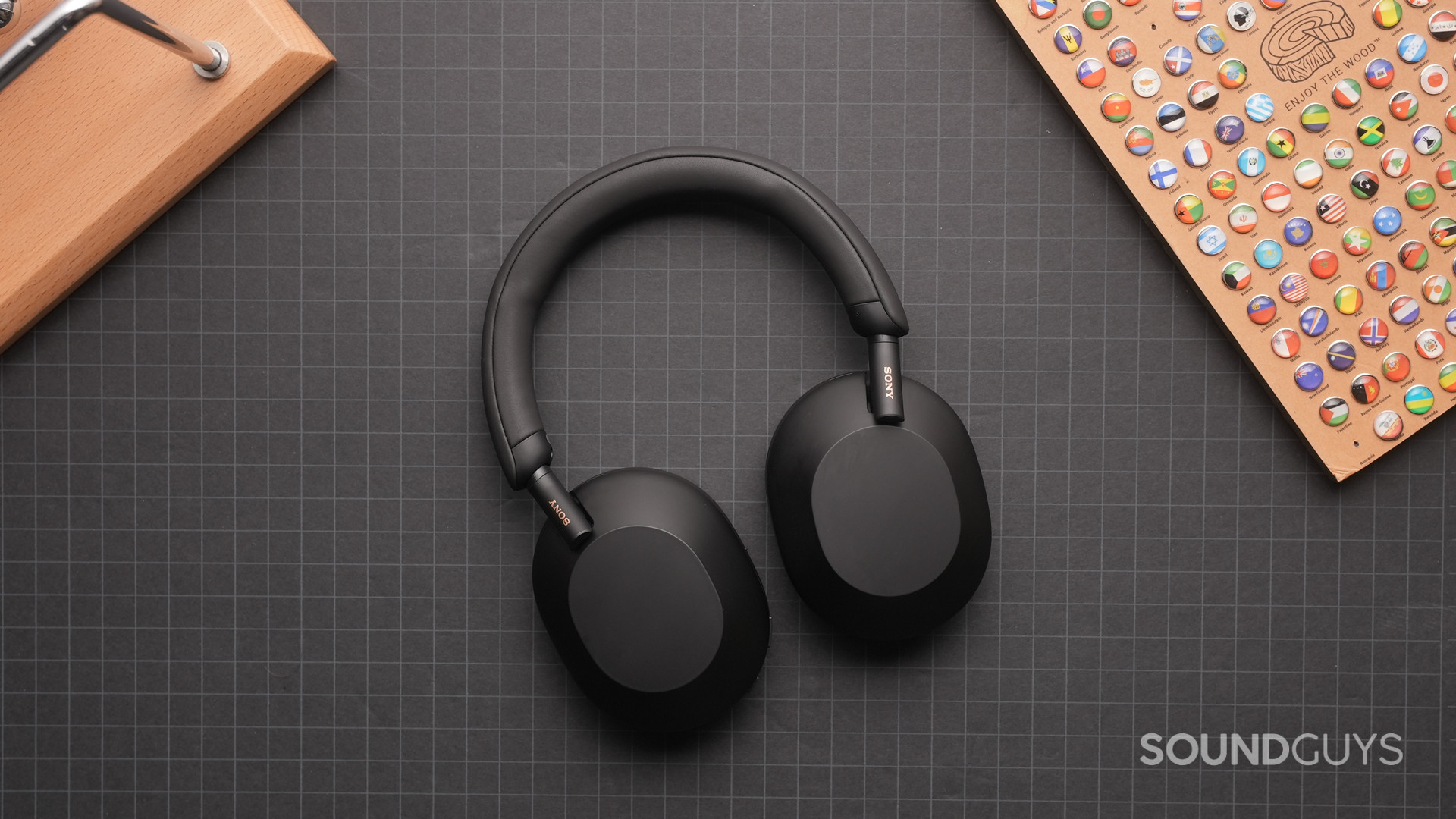
While the WH-1000XM4 is clearly great, there are other options worth considering. All of the following picks are more or less in the same price range, so if you’re looking to save a lot of money, check out our list for the best noise canceling headphones under $100—you won’t get all the bells and whistles, but there are still lots of great options.
If you’re looking for the newest and the best, the most recent update to this line of headphones has arrived in the form of the Sony WH-1000XM5. The design is completely overhauled compared to both the WH-1000XM3 and the WH-1000XM4, but for the most part it maintains the same sound quality and set of features. You can read more about it in our detailed comparison of the Sony WH-1000XM5 vs Sony WH-1000XM4.
Also, the Sony WH-1000XM3 is hardly yesterday’s trash. These headphones sport top-notch noise canceling, A+ battery, and mainly only trade the multipoint Bluetooth for the addition of aptX and aptX HD support. If lack of multipoint doesn’t matter to you, you might as well save yourself some cash and pick this up when it inevitably go on sale. Read our Sony WH-1000XM3 vs WH-1000XM4 article to learn more, and find these for $349.99 at Best Buy.
The Shure AONIC 50 definitely doesn’t have as much hype as products from Bose and Sony, but it’s awesome. This rocks all the latest specs and Bluetooth codecs just like the WH-1000XM4, can use a USB-C cable as a wired connection, and it looks pretty great. The premium build quality, great sound, and impressive noise canceling earn this an editor’s choice award. However, its debut price was more expensive ($298 at Amazon), so this is definitely the upgrade pick. Read about how it compares against Sony here.
The Bowers & Wilkins PX7 is a great headset if you value ANC performance and style, but what holds the PX7 back is its price($99 at Amazon). If you can swallow it, you’ll be met with another hurdle: the exaggerated bass emphasis. The Bowers & Wilkins PX7 renders sub-bass and bass notes two times louder than mids, which can be a real detriment to music enjoyment (unless you’re a bass head, of course).
The Sennheiser PXC 550-II lacks a few of the top-tier features you’d expect of headphones (like USB-C charging), but for $299.99 at Walmart, it’s an almost-unbeatable pick. You’ll get a sleek design, superb noise canceling, Bluetooth multipoint, and great sound quality to boot. Definitely give this some consideration if you’re not sure how much money you want to spend. You can read about how it compares to the WH-1000XM4 to learn more.
Sennheiser’s newer top-of-the-line model, the Momentum 4 Wireless, is also a very viable option, with excellent sound quality, ANC, and connectivity options, albeit at a premium. You can get it for $289.23 at Amazon.
Frequently asked questions about the Sony WH-1000XM4
Yes the Sony WH-1000XM4 has Bluetooth multipoint, which allows you to switch between two devices. The instructions are above, but if it doesn’t work, here is another way. To do this you need the Sony Headphones Connect app on your smartphone and connect both devices to it via Bluetooth as usual. In the app Settings enable connecting to two devices at once. In the Status tab you can manage your connections. This way if you’re listening from your PC and you get a call you can use your touch panels to answer your phone and automatically switch.
Yes, you can use the Sony WH-1000XM4 for noise canceling only. The ANC remains active even without any audio signal being played back as long as you keep them switched on.